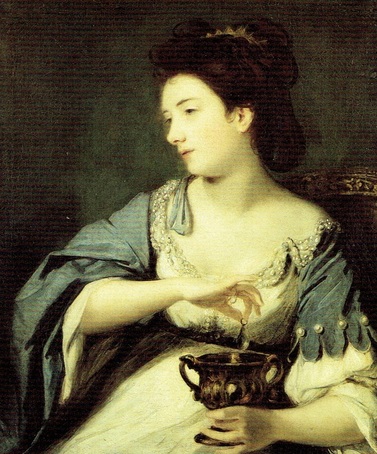 Kitty Fisher as Cleopatra Dissolving the Pearl 1759 by Joshua Reynolds
Kitty Fisher as Cleopatra Dissolving the Pearl 1759 by Joshua Reynolds I was walking back to my office early one afternoon through the main entrance-hall, where a sweeping red-carpeted staircase leads to an upper gallery and portraits of former Headmistresses gaze watchfully down. I stopped for a chat with Sheila, one of the cleaning-ladies, by the large round oak table.
"Are you alright, Sheila?" I asked. It occurred to me that she seemed rather flustered and looked unusually pale.
"I'm feeling a bit funny actually," she answered. "I think I've just seen Kitty Fisher."
Kitty Fisher was reputedly the school's main ghost. "Really?" I asked, trying to dampen my excitement.
"Well, I was polishing the table, and I heard the front door open, and I thought, oh that's one of the girls coming back from lunch, so I didn't think anything more of it, I heard her going up the stairs, then I looked up and saw a woman walking up there. She was wearing a black cloak, and this sort of white frilly thing round inside the edge of her hood. Anyway, halfway up the second lot of stairs, she just vanished! ... Ooh, it did give me a turn ..."
There has been a house at Hemsted even before William the Conqueror gifted the land to his brother Odo. Queen Elizabeth I visited the Catholic recusant Guldeford family, whose house no longer stands, bar the old ice house well tucked away amongst the rhododendrons. 400 years on, two other Queen Elizabeths were to follow: our present Queen, who sent her daughter Princess Anne to school here, and her own mother, Queen Elizabeth the Queen Mother. The three founders of Benenden School bought the country mansion of Hemsted House in 1924 (future pupils included the daughters of Agatha Christie and Enid Blyton), and during the Second World War the school evacuated to Newquay in Cornwall, while Hemsted became a Military Hospital. Its patients included shot-down German Luftwaffe crew-members. The Free French pilot Captain Jean Maridor lost his own life when he moved in to tip the wing of a doodle-bug threatening the hospital, thus saving many others.
No surprise, then, that over the centuries, there may have lingered a memory of those who lived, and sometimes died, here. One of the groundsmen told me that he had once seen a girl in school uniform walking past a building, and initially thought nothing of it until he remembered it was the school holidays. The domestic bursar on several evenings glimpsed a lady silently approaching along the passage in the old Bachelors' Wing.
Then there was the occasion, in the 1960s, when ouija boards were in fashion, and a small group of girls in one of the boarding-houses gave themselves quite a fright. The glass had just commenced to move, and to spell out the word F-I-R-E, when, no more than a couple of seconds later, the school fire-alarm went off, and the whole school was evacuated while a blaze in the old stable-block was dealt with. The story went round the school rapidly, and the Bishop of Dover was brought in the following Sunday to give a strict sermon on the follies of messing with the supernatural.
The head of maintenance, whilst working alone, recalled a moment in the middle of repairing a sky-light at the top of the house when a cold hand had touched the back of his neck. He'd retorted "Don't be so bloody stupid, Kitty - this is dangerous!"
Kitty Fisher is of course still widely remembered in verse, as she is too in local folk history, and new girls are still encouraged by their peers on a certain night of the year to run through a brick tunnel in the grounds (no doubt Victorian!) where they are told the ghost of Kitty Fisher lurks.
Kitty was one of the most famous members of the 'fair and frail' ladies of the eighteenth century 'demi-monde', coming into prominence first at the age of nineteen in 1758. It is believed that she was born in Soho, the daugher of John Fischer, of German Lutheran extraction. She had many admirers, and was painted several times by Joshua Reynolds. She was also a greatly spirited horsewoman (I wonder whether Patrick O'Brian partly based the character of Diana Villiers on her?), and as mentioned above, recorded by name in the child's nursery-rhyme which begins "Lucy Lockett lost her pocket".
In the autumn of 1766, Kitty was happy to marry, with mutual affection, John Norris, the son of a Kentish landowner, grandson of Sir John Norris, Vice-Admiral of England, and the owner of Hemsted House in Benenden. Her sympathetic nature and readiness to offer assistance to anyone in distress was noted by the local working people, and had been chronicled earlier in life. In Ladies Fair and Frail by Horace Bleackley, the following story of her girlhood was reported:
'While paying a visit to Paddington, a rural suburb much patronised by the jaded Londoner during the summer months, she chanced to lodge in the same house with a delicate boy named Henderson, who had been brought thither for change of air. He was a youth of great promise, apprenticed to Mr Clee, "the ingenious engraver of Oxenden Street", and he had fallen into a decline. Touched by his sufferings, and full of compassion for his widowed mother, the good-natured Kitty took an interest in the poor lad. It was a brief friendship. One day she heard him coughing violently, and knowing that he was alone she rushed to his assistance. Upon entering his room a glance told her that the attack was serious, and while she was trying to soothe him he died in her arms. Years afterwards the great actor, John Henderson, used to tell the tale, for although so much infamy was attached to her name, he remembered that Kitty Fisher had been a kind friend to his dead brother.'"
Sadly, Kitty had very little time left herself. Only months after her wedding, during the winter of 1766, a hollow cough grew deeper and more painful, while an accompanying hectic blush in her cheeks betrayed the presence of consumption. An immediate visit to the Bristol Hotwells was prescribed, and Kitty, resigned and patient, embarked on her final journey, a three day coach-ride in bleak weather. She died en-route, at the Three Tuns tavern in Stall Street, Bath, and was buried, on 23rd March 1767, in the Norris family vault in the chancel of Benenden Parish church.

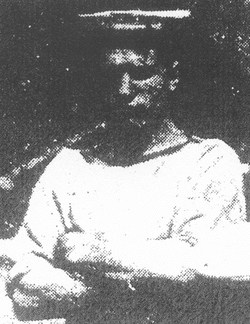
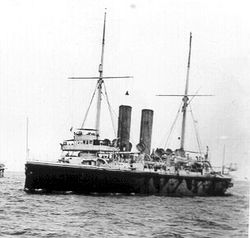
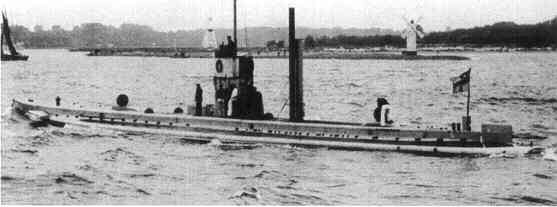
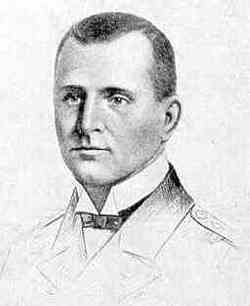

 RSS Feed
RSS Feed
